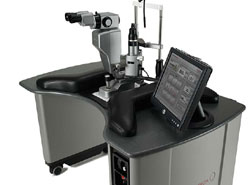Santa Clara, California-based OptiMedica has won the gold award at this year's Medical Design Excellence Awards in New York for the development of an innovative laser photocoagulator called Pascal.
Laser photocoagulation to treat retinal diseases caused by diabetes has changed little in the past 35 years. Laser photocoagulation involves the controlled destruction of the peripheral retina using targeted laser pulses.
While this type of treatment has proven effective at reducing the chances of vision loss by as much as 50 percent, it can be very tedious to both patients and doctors. Ophthalmologists can deliver only one burn at a time, and treatment can require as many as 2,000 burns. A full course of treatment typically requires two to four sessions, each lasting 12 to 15 minutes.
The Pascal photocoagulator reduces this treatment duration as well as patient discomfort. It also can reduce the number of treatment sessions, reducing costs to both doctors and patients.
Rather than develop a custom control system for the Pascal photocoagulator, the engineers at OptiMedica decided to build theirs around a National Instruments R Series intelligent DAQ device. This is a multifunction data acquisition board that uses an FPGA-based system timing controller to make all analog and digital I/O configurable. The engineers at OptiMedica progammed the FPGA chip by creating LabVIEW block diagrams with the National Instruments LabVIEW FPGA Module.

With conventional methods of retinal laser photocoagulation, the physician uses a mechanical joystick and foot pedal to deliver single 100 millisecond laser pulses to abnormal blood vessels of the peripheral retina.
The Pascal system, on the other hand, automatically delivers multiple, shorter pulses rather than a series of manually placed lesions allows for greater precision and safety. Furthermore, the system reduces the risk of inadvertent application of the treatment to the fovea, which can result in localised vision loss - physicians using conventional methods of photocoagulation must manually attempt to avoid this critical region of central vision.
By programming in LabVIEW FPGA, the design engineers were able to vary the timing and power of each pulse to optimise for speed and precision while still protecting the fovea by creating patterns with integrated foveal exclusion zones. By reducing the laser pulse time from 100 milliseconds to just 10 milliseconds, and then automating multiple spots with each depression of the foot pedal, the Pascal system reduces the overall procedure time, as well as the amount of discomfort felt by the patient.

OptiMedica's Pascal photocoagulator.
From the main control panel, an LCD display with a touch screen control is used to select from predetermined pattern types and administer up to 25 spots at a time. All the equipment is very similar to conventional, single-shot photocoagulation, with a mechanical joystick and foot pedal, so physician training is minimal.
Once the pattern is selected, a separate red beam is used for aiming and visualisation of the placement before delivery. The touch screen interface is also used for selecting various parameters, such as aim beam intensity, treatment laser power, exposure time, system status, and shut down. Because each pulse size and pattern is predictable, Pascal photocoagulation is a more precise way to evenly distribute patterned spots, which also increases the reproducibility of results for each treatment.




April 1886: the Brunkebergs tunnel
First ever example of a ground source heat pump?